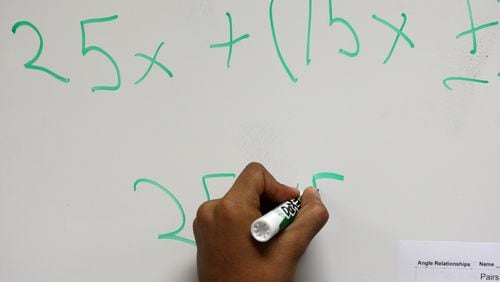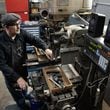In its annual benchmark report on college readiness released today, the ACT found only 40 percent of 2018 graduates who took the test -- including Georgia teens -- posted scores indicating they were ready for first-year college algebra.
The one-point decline in readiness from 2017 continues a downward trend; in 2012, 46 percent of test-takers earned scores that met or surpassed the ACT College Readiness Benchmark in math.
The ACT admissions exam covers math, English, reading and science. The highest possible score in each area and in the composite is a 36. While Georgia’s 2018 average composite score of 21.4 held steady from 2017, the national average dropped slightly to 20.8.
Georgia posted its best performance in English where 65 percent of 2018 test-takers met the college-ready benchmark, compared to 40 percent in math, 38 percent in science and 49 percent in reading.
As Education Week reports:
The newest batch of ACT scores shows troubling long-term declines in performance, with students' math achievement reaching a 20-year low, according to results released Wednesday.
Matt Larson, the immediate past president of the National Council of Teachers of Mathematics, said the math scores "are extremely disappointing, but not entirely unexpected."
Larson said that states have made solid progress adopting good math standards, but the ACT results suggest that schools need to focus on improving curriculum and instructional practice to bring those expectations fully to life. "As a country, we've reached the limits of what we can get out of standards alone," he said. "We need to pay more attention to what is taking place in the classroom."
In a statement, ACT CEO Marten Roorda said, “The negative trend in math readiness is a red flag for our country, given the growing importance of math and science skills in the increasingly tech-driven US and global job market. It is vital that we turn this trend around for the next generation and make sure students are learning the math skills they need for success in college and career.”
You can go to almost any school district in America and find a robust discussion on how to teach math and what to teach, especially at the high school level.
Many states, including Georgia, experimented with intensifying high school math requirements in the belief students would benefit.
For example, algebra II became a gateway course in many states after research showed it predicted college and career success. But states retreated after the push for more advanced math classes became an obstacle to students finishing high school. There was also a rethinking of the value of putting more and more kids in higher levels of math.
As tech guru Ted Dintersmith, author of "What School Could Be" and "Most Likely to Succeed,” said, "If there were 10,000 adults right now at a conference in Atlanta and you asked how many of them use calculus in their daily lives, the answer would be zero to three.”
One problem: Surveys of teachers have shown many in elementary and middle school did not feel prepared to teach the more rigorous math foundation necessary to undergird algebra II in high school. (I recently wrote about Chinese education where even very young students are taught by a dedicated math teacher, which helps explain that country’s superior math skills.)
A few years back, I wrote about a study out of the University of California, Irvine, that challenged the practice of using games and hands-on activitives to develop math skills in young students. That 2014 study found traditional math instruction -- what many call "drill and kill" -- was more effective in helping young children struggling in math than group work, peer tutoring or hands-on activities that use manipulations, calculators, movement and music.
What worked better for struggling students were teacher-directed activities, which researchers described as "using textbooks or worksheets, giving students lots of time to practice skills being modeled by the teacher, more explicit types of instruction."
When I interviewed William H. Schmidt, an internationally recognized researcher on effective math education, he told me something that may explain why we still struggle with getting math education right: It’s not fun.
"What I learned from all the international research, from kids all around the world who are doing the best on the tests, is that they don't like math particularly and they find it hard. We just keep believing in a magic grail, a magic bullet, that will somehow make it easy," Schmidt said. "I have a degree in mathematics. I never really found it fun. I was always nervous when I had a test because I knew it would not be easy. Math is hard; it's hard for the teachers and it's hard for the kids."
With that background, here is a release from the University of California, Los Angeles, that touches on math instruction:
"Horrendous" is a word James Stigler uses to describe how little math many U.S. students learn in middle schools and high schools.
He should know; Stigler, a UCLA professor of developmental and cognitive psychology, has been studying how much math and science students have been learning since the late 1970s.
Based on placement tests, a staggering 60 percent of U.S. students who enter community colleges are not qualified to take a college mathematics course, even though they have graduated high school, Stigler said.
"Many of them never graduate for that reason," he said.
Stigler has also analyzed how other countries — such as Australia, Japan, the Netherlands, Switzerland and the Czech Republic — teach math and science, which, he says, helps us understand U.S. teaching practices more clearly.
"American students think math is about memorizing procedures," Stigler said. "They're not learning in a deep way. They think learning is supposed to be easy. That's really not what learning is about. Students need practice in the things they can't learn by doing a Google search. They need to think and struggle — like when they are practicing a sport or a musical instrument."
In other countries, students are asked to work on a variety of problems. In the U.S., students work on many repetitions of, essentially, the same problem, making it unnecessary for U.S. students to think hard about each individual problem. We teach math as disconnected facts and as a series of steps or procedures — do this, and this and this — without connecting procedures with concepts, and without thinking or problem-solving. "Don't just memorize it and spit it back on the test," Stigler said.
American eighth graders, for example, rarely spend time engaged in the serious study of mathematical concepts, Stigler said. Japanese eighth graders, in contrast, engage in serious study of mathematical concepts and are asked to develop their own solutions for math problems that they have not seen before.
Stigler thinks this memorization of facts and procedures applies to the teaching of many subjects in the United States.
Improving teaching has proven to be extremely difficult, and efforts to do so have achieved only limited success. But this disappointing record has not discouraged Stigler.
One of his projects, funded by a grant from the Chan Zuckerberg Initiative, is to create and continually improve a university course. The course, which focuses on introductory statistics, includes an online, interactive "textbook" with more than 100 web pages and about 800 assessment questions. Stigler began creating the course in 2015 in collaboration with Ji Son, a professor at Cal State Los Angeles, and Karen Givvin, a UCLA researcher and adjunct professor of psychology. He taught the course for the first time last spring and is doing so again this quarter.
As students work their way through the course, Stigler and his team collect all the data and can see what the students are learning and what they are not learning.
"Most professors don't realize how little information we have about how much students are learning," Sigler said. "I observed a professor once give a lecture where not a single student said anything. I asked him afterwards how he thought it went, and he thought it was great. But how could he tell if it was clear to the students without eliciting any information from students?"
With his interactive course, Stigler can get real-time information. He offers his statistics course for free to any instructor in exchange for getting access to the data showing what, and how, students are learning.
His goal is incremental improvement in teaching, believing that rapid, dramatic results are not realistic. "I want millions of students to get one percent better every year in what they learn," Stigler said.
Stigler and Givvin are playing leading roles in a new organization, the Precision Institute — created by National University to test innovative teaching ideas and collect data with the goal of helping to solve some of the most challenging issues in higher education. Stigler is one of the institute's first fellows. National University, a San Diego-based non-profit, offers more than 100 programs, both online and at more than two dozen locations in California and Nevada, and has more than 150,000 alumni.
Through the Precision Institute and its National Precision Research and Innovation Network, National University gets researchers to address its educational challenges, while researchers get to test their education theories in real time in a university setting.
Stigler hopes to add his statistics course to the National University curriculum. Ideas that work can be implemented at National University right away.
Students in the same course can be randomly assigned to use different materials, and Stigler and his team can analyze data and figure out which approach is more effective. Stigler will soon do this in his UCLA undergraduate statistics course and will bring this approach to the National University project as well.
"We're improving the course while students are taking the course," said Stigler, who believes strongly in the importance of collecting data to see what actually helps students learn. "We're trying to measure what they actually learn and figure out how we can help them to learn more."
Any academic content area could profit from this approach, and the intent of Stigler's research team is to broaden its application in the future.
"I don't know what the answers are and don't have an ax to grind," Stigler said. "I don't want to argue in the abstract about theories of education. Let's test ideas on the ground and see which ones help students."
Teaching is hard to change. Stigler and Givvin are struck by how similar teaching methods are within each country they have studied, and the striking differences in methods they observed across countries. While the United States is very diverse, the national variation in eighth grade mathematics teaching is much smaller than Stigler and Givvin expected to find.
"The focus on teachers has some merit, of course," Stigler said, "but we believe that a focus on improving of teaching — the methods that teachers use in the classroom — will yield greater returns.
"Even the countries at the top are trying to improve teaching and learning," Stigler said. "It is a central problem faced by all societies."
About the Author







